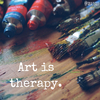Making Art Work: Community at a Distance (Part One)
Making Art Work: Community at a Distance
As 2020 has proven, adaptability is the best tool in every artist’s skillset. Thankfully, technology has been able to offer a large array of options for artists to use to help recreate their classroom settings in a digital space.
We have created a list of some of the most well-known and versatile online programs artists can use to incorporate into their art classes.

Zoom (Zoom Meetings) – A business-focused app based in San Jose CA, Zoom is a commonly used among teachers and community organizers, offers peer-to-peer video and chat services pertaining to telecommuting, distance education and social relations. Zoom allows for up to 100 participants to join one stream in 40 minute meetings (For free accounts. There are paid account options that offer more than that. Zoom can work across all platforms (Cell Phone, Laptop, Desktop, etc)
Visit https://zoom.us/ for more information.
Google Hangouts – Possibly the most accessible option to those with a google account (Gmail, G Suite Basic Income account, etc). Hangouts offers up to 10 people to chat per video meeting/call. Recently, Google has lifted certain restrictions to allow for video conferences for up to 250 participants (through July 1st, 2020). Hangouts can work across all platforms. (Cell phone, Laptop, Desktop)
Visit https://hangouts.google.com/ for more information.
Skype – Originally released in August of 2003, Skype is one of the most well-known telecommunication applications on the internet. With conference call options for up to 50 people free of charge and include a number of different features (including cloud-based recording).
Visit https://www.skype.com/en/ for more information.
GoToMeeting - The oldest communication software (released in 2004), GoToMeeting allows for up to 250 participants and has a number of options for users.
Visit https://www.gotomeeting.com/ for more information.
Discord – Founded 4 years ago, Discord is a gaming and education-based software that specializies in text, image, video and audio communications via chat channel. This service is more known in younger communities, which may allow for easier access for students.
Visit https://discord.com/ for more information.
These programs can be helpful for any artist with a cell phone, desktop or laptop to organize online classes, critique sessions or life drawing
Other options:
“Going Live” – Many social media platforms (Facebook, Instagram, Youtube, etc.) offer the ability to livestream. While this is not the most effective feature for an instructional or classroom experience, you can still create in front of a live audience, or share a lesson or drawing, or just be social with people. These streams are often erased after 24 hours, be aware.
Hopefully this list is helpful for you! If there are any resources we missed, tell us in the comments!







